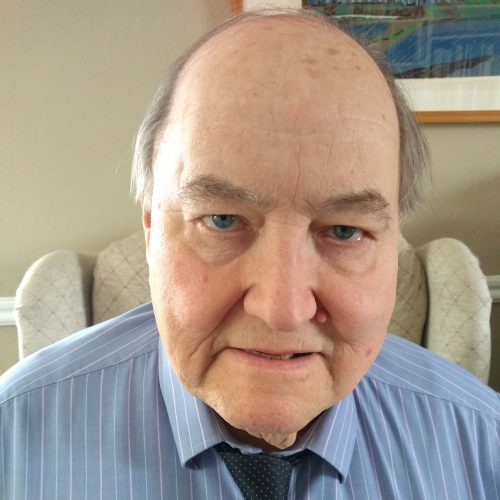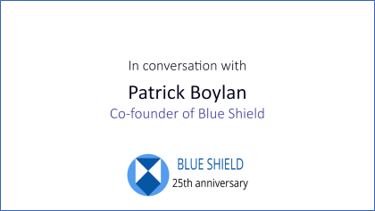
The Blue Shield is deeply saddened by the passing of Patrick Boylan, a leading figure in cultural property protection and one of the founders of the Blue Shield Movement, aged 84. He passed away following a short illness, after struggling for some time with health problems including dementia.
“Born just two weeks before the start of World War II in the English port city of Hull, Yorkshire, that was to suffer the most severe and sustained bomb damage of any town in the United Kingdom’, my earliest memories are of war: the destruction of our family home when I was only eighteen months old: a single but clear memory of my paternal grandparents before they were killed along with over sixty neighbours less than three months later in a communal shelter just two hundred metres from the main railway line to the docks of the country’s third most important port. However, even the worst of those experiences left me unprepared for the vast areas of total destruction seen during my first visits to Rotterdam and Koln in the early 1950s.”
Patrick J. Boylan, London, 30 April 1993 (Foreward to the Review of the Hague Convention, 1993) Tweet
In addition to illustrious careers in heritage management and academia, Patrick Boylan was instrumental in developing heritage protection in armed conflict as we know it today. In 1993, Patrick was hired by UNESCO to undertake a Review of the Convention for the Protection of Cultural Property in the Event of Armed Conflict (The Hague Convention of 1954). This vital legislation was the first widely internationally signed treaty regulating the protection of cultural heritage in armed conflicts, placing obligations on states parties and their armed forces to make preparations for safeguarding cultural property in peacetime, and then to also take measures during conflict to protect it and to minimise the effect of combat. At the time of the review, however, just 82 States were party to the Convention, and 68 to its First Protocol (also 1954). Patrick’s pivotal review found that the Convention was “still entirely valid, […] applicable and relevant” but with some deficient areas, and he made a large number of valuable recommendations. There were two major outcomes, which he was instrumental in realising.
The first was the founding of the Blue Shield, an aspiration of the drafters of the 1954 Hague Convention that was not realised. His review found that:
“Non-Governmental Organisations also have an important role to play [as their] status can also give them a very considerable advantage over governmental and inter-governmental organisations in cases where there are serious political problems making the practical involvement of bodies such as UNESCO impossible. […] Non-governmental organisations … are … exploring the possibility of creating some form of non-governmental ‘Blue Shield’ international organisation for cultural property, as a direct parallel of the Red Cross in relation to other areas of humanitarian assistance.’ […] Non-governmental organisations have the potential to play a most important role in providing direct assistance in terms of professional and technical labour, specialised equipment and materials for protection and emergency conservation, and for assisting with the temporary evacuation of important movable cultural property in times of actual or threatened armed conflict”.
Following a number of conversations which Patrick was heavily involved in, in 1996, Patrick, as Vice-President of ICOM, came together with George MacKenzie, the ICA Deputy Secretary-General, Dinu Bumbaru, of the ICOMOS International Executive Committee, and Marie-Therese Varlamoff, Director of IFLA Preservation and Conservation Core Activity, to found an organisation that could bring together the heritage sector to react quickly to the destruction of heritage in conflict and crisis, promoting coordination and the sharing of cross-sectoral expertise – the Blue Shield.
"If you have a threat or an actual disaster you need to look to the whole of the conservation and cultural heritage family for support."
Patrick Boylan, Founder Tweet
"Our vision is that in time the Blue Shield should become for cultural heritage protection what the Red Cross is for humanitarian protection."
George MacKenzie, Founder Tweet
That organisation has continued to grow: 2023 saw the approval of Blue Shield’s 31st national committee, in Italy, with many more under construction in every inhabited continent. It is active in conflicts, disasters, and safeguarding preparations around the world, and has MoUs with a number of major organisations, including the International Committee of the Red Cross.
In 2021, the Blue Shield founders were presented with an Advocacy Award by the International Institute for Conservation. As part of that award, they participated in a panel where they talk about the founding of the Blue Shield.
The second outcome was the creation of a new international Protocol in 1999 to augment the 1954 Hague Convention and its 1954 Protocol. The new Protocol, which Patrick was prominent in drafting, supplemented apparent deficiencies in the Convention, provided definitions over areas that lacked clarity, and updated the legislation in line with advances in international law. It also created a new category of protection for cultural sites, called enhanced protection, for example. This year is Protocol’s 25th anniversary (and the 70th anniversary of the Convention), and there is no doubt one of its founding drafters will be well remembered.
Patrick’s contribution of the field of heritage protection in conflict cannot be overstated. However, he also directed museums, arts and archives services in England before becoming Professor and a Head of Department at City University, London. In that time he was devoted to supporting the next generation of heritage professionals, supervising 25 successful PhD students and over 200 MA projects. He has authored numerous publications on the protection of culture in times of war, and worked as a consultant to UNESCO, EU, World Heritage Committee, Council of Europe, World Bank and many national governments. He was the Centenary President of The Museums Association (UK) 1978-1980, and Vice-President of the International Council of Museums (ICOM) 1992-1998, amongst other posts.
In addition to his academic legacy, Patrick’s influence on international law remains profound. Today the Convention is ratified by 135 countries, covering most of the area of the world, and Patrick’s work across five continents is in no small part responsible for the 86 ratifications of the Second Protocol, increasing each year. In December 2023, the number of sites placed under Enhanced Protection doubled as States Parties are realising the value of the protective system Patrick helped develop. Working in partnership with our founding four organisations, the Blue Shield has become a global Movement, bringing together heritage professionals to work in crisis and conflict around the world.
Patrick knew
“The loss of the physical or spiritual cultural heritage of one people is a loss for the whole of humanity. This loss is not just a loss for the people or community directly deprived of the evidence of their own past and present culture: the consequence is ultimately no less grave for those who may have deliberately brought it about. […] It is not unreasonable for the world community to seek to protect its cultural inheritance, and pass it on to future generations, even in the most extreme emergencies of war.” (Foreward, 1993 Review)
Today we hope we can continue to promote his remarkable legacy.





